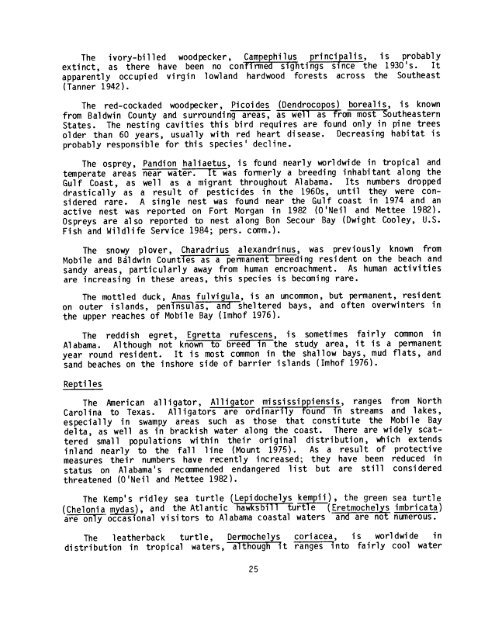ecological characterization atlas of coastal alabama - Data Center
ecological characterization atlas of coastal alabama - Data Center
ecological characterization atlas of coastal alabama - Data Center
You also want an ePaper? Increase the reach of your titles
YUMPU automatically turns print PDFs into web optimized ePapers that Google loves.
The ivory-billed woodpecker, Cam pe hilus principalis, is probably<br />
extinct, as there have been no con irme sig tings since the 1930's . It<br />
apparently occupied virgin lowland hardwood forests across the Southeast<br />
(Tanner 1942) .<br />
The red-cockaded woodpecker, Picoides (Dendrocopos) borealis, is known<br />
from Baldwin County and surrounding areas, as we as rom moutheastern<br />
States . The nesting cavities this bird requires are found only in pine trees<br />
older than 60 years, usually with red heart disease . Decreasing habitat is<br />
probably responsible for this species' decline .<br />
The osprey, Pandion haliaetus, is found nearly worldwide in tropical and<br />
temperate areas near wateṙ -T was formerly a breeding inhabitant along the<br />
Gulf Coast, as well as a migrant throughout Alabama . Its numbers dropped<br />
drastically as a result <strong>of</strong> pesticides in the 1960s, until they were considered<br />
rare . A single nest was found near the Gulf coast in 1974 and an<br />
active nest was reported on Fort Morgan in 1982 (0'Neil and Mettee 1982) .<br />
Ospreys are also reported to nest along Bon Secour Bay (Dwight Cooley, U .S .<br />
Fish and Wildlife Service 1984 ; pers . comm .) .<br />
The snowy plover, Charadrius alexandrinus, was previously known from<br />
Mobi le and Bal dwin Counties as a permanent breedi ng resi dent on the beach and<br />
sandy areas, particularly away from human encroachment . As human activities<br />
are increasing in these areas, this species is becoming rare .<br />
The mottled duck, Anas fulvigula, is an uncommon, but permanent, resident<br />
on outer islands, peni s-u-las an -shelt.ered bays, and <strong>of</strong>ten overwinters in<br />
the upper reaches <strong>of</strong> Mobile Bay (Imh<strong>of</strong> 1976) .<br />
The reddish egret, Egretta rufescens, is sometimes fairly common in<br />
Alabama . Although not known to bree in the study area, it is a permanent<br />
year round resident . It is most common in the shallow bays, mud flats, and<br />
sand beaches on the inshore side <strong>of</strong> barrier islands (Imh<strong>of</strong> 1976) .<br />
Reptiles<br />
The American alligator, Alligator mississippiensis, ranges from North<br />
Carolina to Texas . Alligators are ordinari y oun in streams and lakes,<br />
especially in swampy areas such as those that constitute the Mobile Bay<br />
delta, as well as in brackish water along the coast . There are widely scattered<br />
small populations within their original distribution, which extends<br />
inland nearly to the fall line (Mount 1975) . As a result <strong>of</strong> protective<br />
measures their numbers have recently increased ; they have been reduced in<br />
status on Alabama's recommended endangered list but are still considered<br />
threatened (0'Neil and Mettee 1982) .<br />
The Kemp's ridley sea turtle (Le idochelys ke ~ii), the green sea turtle<br />
(Chelonia mydas), and the Atlantic awcsbi turt~e (Eretmochel s imbricat a)<br />
are only occasional visitors to Alabama c:oastal waters an are no numerous .<br />
The leatherback turtle, Dermochelys coriacea, is worldwide in<br />
distribution in tropical waters, aZ tiougTiit ranges nto fairly cool water<br />
25
















